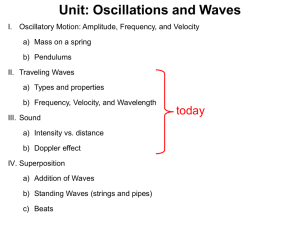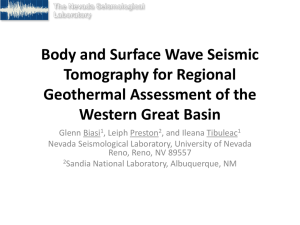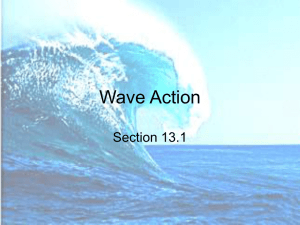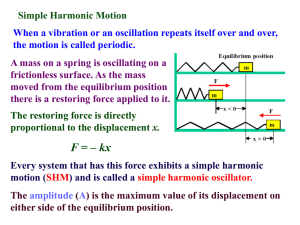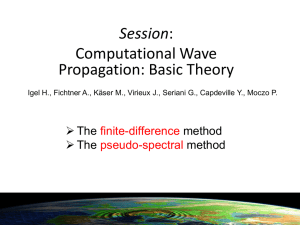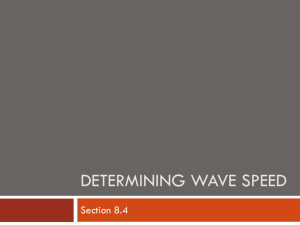Waves I - Galileo and Einstein
advertisement
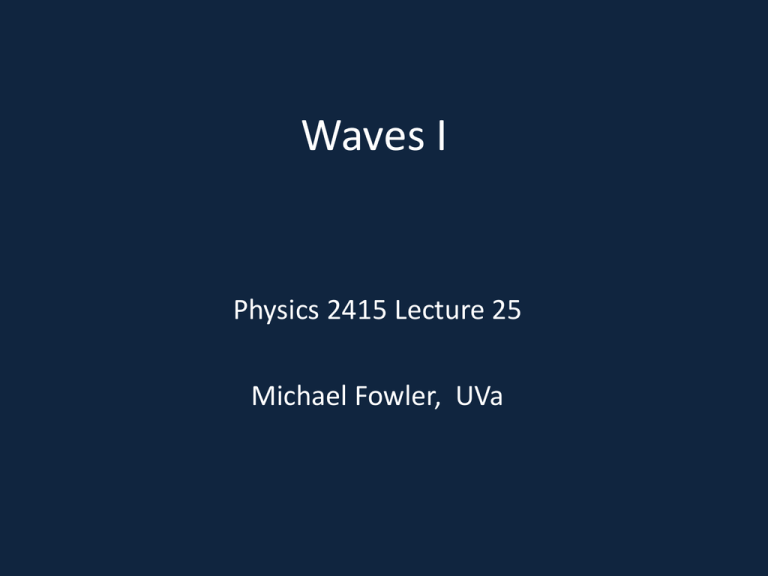
Waves I Physics 2415 Lecture 25 Michael Fowler, UVa Today’s Topics • • • • Dimensions Wave types: transverse and longitudinal Wave velocity using dimensions Harmonic waves Dimensions • There are three fundamental units in mechanics: those of mass, length and time. • We denote the dimensions of these units by M, L and T. • Acceleration has dimensions LT-2 (as in m/sec2, or mph per second—same for any unit system). Write this [a] = LT-2. • From F = ma, [F] = [ma] so [F] = MLT-2. Using Dimensions • Example: period of a simple pendulum. What can it depend on? • [g] = LT-2, [m] = m, [ℓ] = L. • What combination of these variables has dimension just T? No place to include m, and we need to combine the others to eliminate L: • [g/ℓ] = T-2, so / g is the only possible choice. • Dimensional analysis can’t (of course) give dimensionless factors like 2. Dimensional Analysis: Mass on Spring • From F = -kx, [k] = [F]/[x] = MLT-2/L = MT-2. • How does the period of oscillation depend on the spring constant k? • The period has dimension T, the only variables we have are k and m, the only combination that gives dimension T is m / k , so we conclude that T 1/ k . • . Spring’s force F kx m Extension x Waves on a String A simulation from the University of Colorado Transverse and Longitudinal Waves • The waves we’ve looked at on a taut string are transverse waves: notice the particles of string move up and down, perpendicular to the direction of progress of the wave. • In a longitudinal wave, the particle motion is back and forth along the direction of the wave: an example is a sound wave in air. Harmonic Waves • A simple harmonic wave has sinusoidal form: Amplitude A Wavelength • For a string along the x-axis, this is local displacement in y-direction at some instant. • For a sound wave traveling in the x-direction, this is local x-displacement at some instant. Wave Velocity for String • The wave velocity depends on string tension T, a force, having dimensions MLT-2, and its mass per unit length , dimensions ML-1. • What combination of MLT-2 and ML-1 has dimensions of velocity, LT-1? • We get rid of M by dividing one by the other, and find [T/] = L2T-2 : • In fact, v T / is exactly correct! • This is partly luck—there could be a dimensionless factor, like the 2 for a pendulum. Sound Wave Velocity in Air • Sound waves in air are pressure waves. The obvious variables for dimensional analysis are the pressure [P] = [force/area] = MLT-2/L2 = ML-1T-2 and density [] = [mass/vol] = ML-3. • Clearly P / has the right dimensions, but detailed analysis proves v P / P / where = 1.4. • This can also be written in terms of the bulk modulus B P / , but that differentiation must be adiabatic—local heat generated by sound wave pressure has no time to spread, this isn’t isothermal. Traveling Wave • Experimentally, a pulse traveling down a string under tension maintains its shape: y vt x • Mathematically, this means the perpendicular displacement y stays the same function of x, but with an origin moving at velocity v: y f x, t f x vt So the white curve is the physical position of the string at time zero, the red curve is its position at later time t. Traveling Harmonic Wave • A sine wave of wavelength , amplitude A, traveling at velocity v has displacement 2 y A sin x vt y 0 x vt Harmonic Wave Notation • A sine wave of wavelength , amplitude A, traveling at velocity v has displacement 2 y A sin x vt • This is usually written y Asin kx t , where the “wave number” k 2 / and vk . • As the wave is passing, a single particle of string has simple harmonic motion with frequency ω radians/sec, or f = ω/2 Hz. Note that v = f
